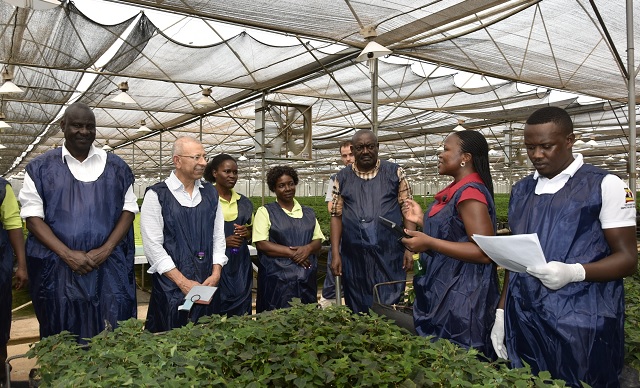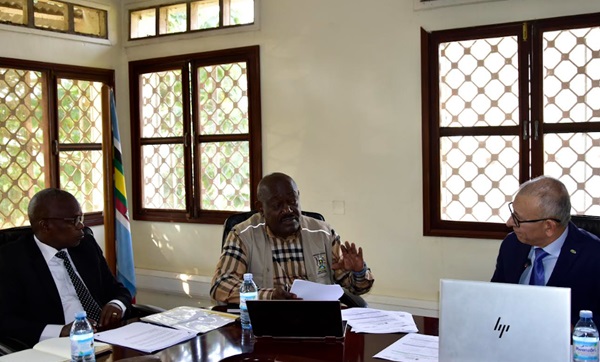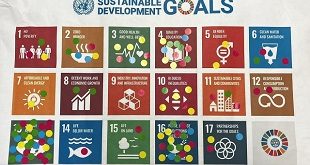
Phytosanitary programme intends to equip all 54 countries with technology and technical capacity
ANALYSIS | RONALD MUSOKE | Agriculture and its related value chains drive most economies across the continent, contributing about 40% to Africa’s GDP and 15% of its exports, 75% to its intra-African trade, and 60-80% of employment.
But the agriculture sector is under threat from pests that are moving faster and more easily across borders because of increased global travel and trade, human population boom, and climate change. The pests are also quickly adapting to new situations to survive.
In the process, they are destroying crops and wild plants, leaving millions of people food insecure and shrinking livelihoods of smallholder and commercial farmers. Unfortunately, not all African countries have adequate technical capacity or phytosanitary infrastructure to prevent, detect and manage pests.
That’s why the the International Plant Protection Convention (IPPC) in collaboration with the African Union and the UN Food and Agriculture Organisation (FAO) have launched a programme to bridge that gap.
Named the Africa Phytosanitary Programme (APP), it intends to equip national plant protection organisations with science-based approaches, advanced technology and tools to monitor, detect, prevent and manage crop pests and diseases.
Under the AU Commission’s department of Agriculture, Rural Development, Blue Economy, and Sustainable Environment (ARBE), the programme is being piloted in 11 African countries. They include Uganda, Cameroon, Democratic Republic of Congo, Egypt, Guinea Bissau, Kenya, Mali, Morocco, Sierra Leone, Zambia and Zimbabwe. It is focusing on strengthening the resilience of the continent’s phytosanitary systems against plant pests “of regulatory, economic, and environmental significance.”
It also intends to expand international and regional market access for agricultural products by supporting national plant protection organisations to facilitate the import and export of agricultural products in accordance with international standards for phytosanitary measures.
Pests wreaking havoc
The International Plant Protection Convention is a global treaty ratified by 184 countries, including Uganda, to protect the world’s plant resources from the spread and introduction of pests but also promote safe trade.
IPPC Secretary visit
On a recent trip to Uganda, Dr. Osama El-Lissy (PhD), the Secretary of the IPPC told senior technocrats in the Ministry of Agriculture, Animal Industry and Fisheries that plant pests continue to cause significant damage to crops around the world.
“This is anywhere between 20-40% of (global) crop loss annually which translates to an economic loss of about US$ 220bn.” In Africa, Dr. El-Lissy noted, the crop losses are between 30-60% which translate to US$65bn in economic value.
“That is why the community (IPPC signatories) came together to have a global phytosanitary programme that would empower countries with the science and technology to deal with those pests in the most effective way before they cause environmental and economic damage.”

Overall, the programme is expected to enhance the capacity to manage and prevent the spread of pests; improve pest surveillance and early warning systems, improve food security and agricultural resilience against invasive plant pests, harmonise phytosanitary practices, including inspection and other regulatory border activities; coordinate regional plant protection strategies, develop technical skills, improve trade facilitation and opportunities as well as enhance regional collaboration on emerging plant health issues.
According to phytosanitary experts, the late detection of these pests and un-timely response has been costly, setting back African countries billions of dollars in control and lost foreign exchange revenue due to reduction in exports.
Africa first to benefit
Local and international experts in the sector say improvements in Africa’s agricultural sector, such as developing robust early warning and surveillance systems for pests, expanding the technical capabilities of phytosanitary personnel and enhancing the functionality of phytosanitary infrastructure, will improve crop production, support socioeconomic development and boost the trade of agricultural products within and from Africa to the world.
During, a train-the-trainer workshop that took place last September in Cairo, Egypt, participants from the 11 pilot countries got the most current scientific approaches and state-of-the-art electronic data collection and reporting tools for timely decision-making on pest prevention.
They were also introduced to mobile application technology which would improve the efficiency of field staff in collecting, recording and using data on plant pests, even in remote areas with no internet connection.
Jennifer Moffitt, the Under Secretary of Agriculture for Marketing and Regulatory Programmes in the United States Department of Agriculture (USDA) which is a pioneer funder of the Africa Phytosanitary programme told the participants that the connections between plant pests, crop losses and food shortages are evident in Africa.
“With plant pests undermining crop production and causing losses between 30-60% annually, the need for effective pest management strategies that address the detrimental effects of plant pests and animal diseases is critical,” she said.
Low capacity in phytosanitary diagnostic and reporting infrastructure remains a key weakness in Africa’s plant health system, as highlighted in the African Union’s Plant Health Strategy for Africa 2022-2036.
“To help African countries eliminate hunger and reduce poverty by raising economic growth through agriculture-led development, it is essential to enhance the continent’s phytosanitary capacity and its productivity in the agricultural sector,” said Josefa Sacko, the African Union Commissioner, Department of Agriculture, Rural Development, Blue Economy and Sustainable Development.
At the meeting with senior technocrats in the agriculture ministry headquarters in Entebbe on July 8, Dr. El-Lissy said the programme has started in Africa because Africa is impacted most by hunger and climate change. The continent also lacks systemic phytosanitary systems that would enable countries to deal with plant pests in an effective way.
El-Lissy said he travelled to Africa to meet and discuss with all the beneficiary countries’ agriculture ministers; their leadership as well as the UN’s Food and Agriculture Organization (FAO) representatives in regards to the programme’s progress.
“We have been asking for commitment from the ministries to ensure that the ministers have the organisation structure to deliver the programme as well as the workforce to be trained to be able to implement the programme.”
Programme’s priority pests
The programme’s priority pests include; Fusarium Tropical Race 4 (TR4) which affects bananas, Xylella fastidiosa (which affects coffee and ornamental plants), Bactrocera dorsalis, Red Palm weevil (palm oil trees), Banana Bunchy top virus (BBTV), Citrus huanglongbing (HLB) or Citrus greening, Fall army worm (FAW) as well as the False codling moth (which affect citrus fruit trees).
Phytosanitary expert say millions of dollars are lost every year across Africa to manage and control pesky pests like fall army worms, desert locusts, fusarium wilt and fruit flies. In Uganda, the agriculture ministry says the country has suffered several devastating effects due to pests such as coffee wilt in the 1990s, Banana Bacteria wilt in 2001; coffee twig borer; and Fall armyworm in 2016, and the False codling moth in 2012.
In the last five years, Uganda has also witnessed new pest incursions including; the Potato Cyst Nematode (PCN), the Banana Bunchy top virus disease (BBTD), Papaya Mealy bug (PMB) and Mango Mealy bug (MMB).
The ministry says it also has new pest threats including; Xylella fastidiosa; Tomato Brown Ragose virus (ToBRV), Khapra Beetle (Trogoderma granarium), Thrips palmi, Thrips sativa, Fusarium Race 4 (FOC4) and Palm weevil (Rhychophorus ferruginous).
Dr. Caroline Nankinga, the Assistant Commissioner for Phytosanitary and Quarantine Inspection Services in the Ministry of Agriculture, Animal Industry and Fisheries told The Independent that out of the eight pests under the Africa phytosanitary programme, Uganda realised that they have most of them in the country.
“So, we chose Xylella fastidiosa and Palm weevil (Rhychophorus ferruginous) because they are not yet in the country but, if they get into the country, they would pose serious economic losses to the country’s palm oil, coffee and flower sectors.”
She told The Independent that the Africa phytosanitary programme is important to Uganda and Africa as a whole because often times, most of these pests attack when the governments are not prepared and all they do is firefight.
She mentioned the government’s experience with the Fall Army Worm and Desert Locusts. “We are getting technical skills and building capacity so that when these pests come, we are able to detect and respond quickly.”
Uganda’s phytosanitary programme
In Uganda, the programme appears to be bearing fruit. For instance, the agriculture ministry has already established a National Plant Protection Organisation (NPPO) which is the contact point for the international collaboration for IPPC activities. The NPPO is now collaborating with other ministry departments and agencies of government to ensure robust plant health.
In addition, the NPPO Department of Crop Inspection and Certification has enhanced border control through the deployment of new inspectors on major entry points.
A collaborative framework for pest surveillance and emergence response has also been developed through wider consultation and will be implemented through expert working groups and the National Technical Working Group. Through these expert working groups, risk analysis has been done for BBTV, Xylella, and Tomato Brown Ragose virus (ToBRV pests.
Dr Paul Mwambu (PhD), the Commissioner crop inspection and certification who also doubles as the head of the National Plant Protection Office (NPPO) in the Ministry of Agriculture, Animal Industry and Fisheries noted during the meeting in Entebbe that the continental initiative is not only critical for Uganda but Africa in general considering agricultural commodities form the backbone of intra-African trade and contribute significantly to the economies of our nations.
Speaking at the same meeting on behalf of the Permanent Secretary of the Ministry of Agriculture, Animal Industry and Fisheries, Ronald Gyagenda Ssegawa told the meeting that, every year, Uganda imports plants and plant products worth more than US$ 479.2 million and exports more than US$, 660 million, to and from different markets globally. He said Uganda also ranks 45 in terms of food exports to the European Union, worth €480 million.
“As a country, therefore, we have the challenge of striking a balance to safeguarding our national agricultural resources by putting less restrictive measures for the trade of agricultural products; nationally, regionally, and internationally,” he said.
 The Independent Uganda: You get the Truth we Pay the Price
The Independent Uganda: You get the Truth we Pay the Price



